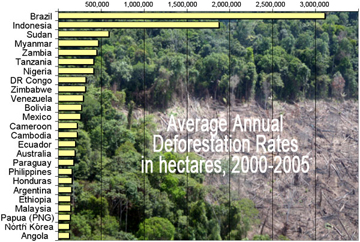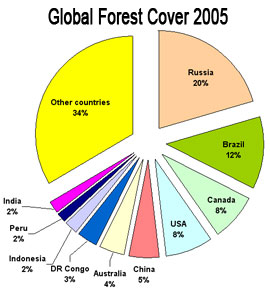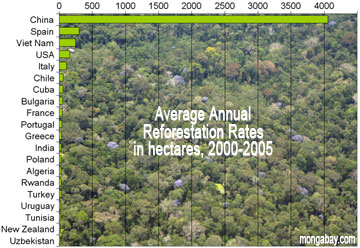Rich countries gain, poor countries lose forest cover
Rich countries gain, poor countries lose forest cover
mongabay.com
March 13, 2007
Tropical deforestation rates continue to accelerate according to a bi-annual report from the Food and Agriculture Organization of the United Nations (FAO) released Tuesday.
But the State of the World’s Forests reports that while forest loss continues in the world’s poorest countries, wealthier nations are seeing increasing forest cover after centuries of deforestation. Overall 57 countries reported an increase in forest area, and 83 reported a decrease between 2000 and 2005.
Globally, forests cover nearly four billion hectares, or about 30 percent of the world’s land area, but between 1990 and 2005 the world lost about 3 percent of its total forest area. A larger percentage of primary or “old-growth” forest disappeared, largely cleared for agriculture, fuel wood, and logging. The figures, which were released more than a year ago in a separate report, show that ten countries account for 80 percent of the world’s primary forests.

Average annual deforestation and reforestation between 2000 and 2005. By Rhett A. Butler, mongabay.com. |
Annual loss of forest cover was highest in some of the world’s poorest countries — especially in Africa, which lost 9 percent of its forests between 2000 and 2005. Leading the list was Brazil, home to the Amazon rainforest, which lost an average of 3,101,000 hectares per year between 2000 and 2005. Brazil was followed by Indonesia (-1,871,000 ha), Sudan (-589,000 ha), Myanmar (-466,000 ha), Zambia (-445,000 ha), Tanzania (-412,000 ha), Nigeria (-410,000 ha), Democratic Republic of Congo (-319,000 ha), and Zimbabwe (-313,000 ha).
Looking at primary forest loss, the United States and Russia land on the list with Russia losing the third largest area of old growth forest between 2000 and 2005, and the United States losing the seventh largest area. Primary forest is defined by FAO as forests with no visible signs of past or present human activities. These forests, often termed “old-growth forests,” have the highest number of plant and animal species and are generally considered a top priority for conservation by environmentalists and government agencies.
Despite the drop in primary forest cover, America still managed to post a gain in total forest cover due to the regeneration of previously cut forests and new forest plantations. These forests are generally considered ecologically inferior to primary forests for their reduced biodiversity but now make up major of American — and world — forests.
The U.S. trend was echoed in other parts of the world. China had by far the largest increase in forest cover — more than 20,000,000 hectares — between 2000 and 2005 as a result of an aggressive reforestation campaign which was initiated following devastating floods in the late 1990s. The next largest gain in forest cover was seen in Spain (1.4 million ha between 2000 and 2005), followed by Vietnam (1.2 million ha) and the United States (795,000 ha).

Forest cover in 2005. By Rhett A. Butler, mongabay.com. |
Globally, forest cover has generally been expanding in North America, Europe and China while diminishing in the tropics. Plantations help offset the loss of natural forests but essentially result in an overall decline in global biodiversity as single species plantations replace their biologically richer natural counterparts.
THe FAO report notes that while many countries are paying more attention to forests for their ecological services value, poor and conflict countries are having a tough time meeting forest management goals.
“Many countries have shown the political will to improve forest management by revising policies and legislation and strengthening forestry institutions. Increasing attention is being paid to the conservation of soil, water, biological diversity and other environmental values,” said David Harcharik, FAO Deputy Director-General. “However, countries that are facing the most serious challenges in achieving sustainable forest management are those with the highest rates of poverty and civil conflict.”
The report also notes that there is mounting evidence that forests will be “profoundly affected by climate change” putting them at increased risk of pests, disease, and forest fires. It says that 80-99 percent of forest fires are manmade.
The report concludes by offering hope that sustainably forests can help fight global warming while providing renewable resources and valuable ecological services to humanity.
Related articles
World deforestation rates and forest cover statistics, 2000-2005
Nigeria has the world’s highest deforestation rate, Brazil loses the largest area of forest annually, and Congo consumes more bushmeat than any other tropical country. These are among the findings from mongabay.com’s analysis of new deforestation figures from the United Nations.
United States has 7th highest rate of primary forest loss
Primary forests are being replaced by “modified natural,” “seminatural,” and plantation forests in the United States according to new deforestation figures from the United Nations.
